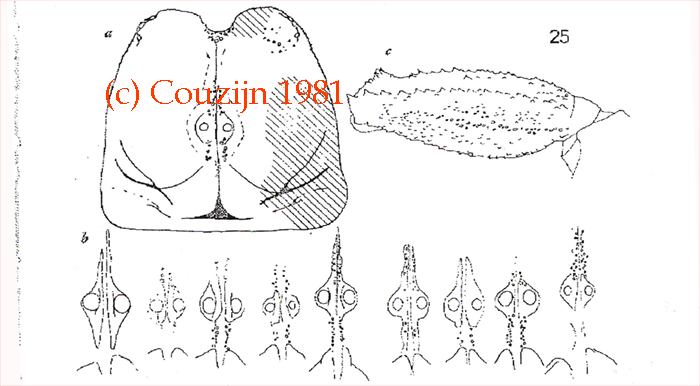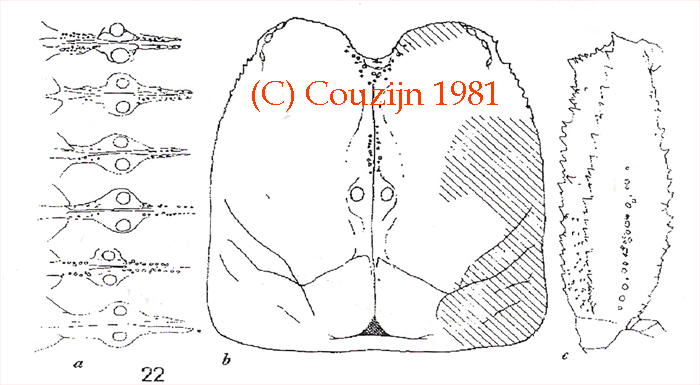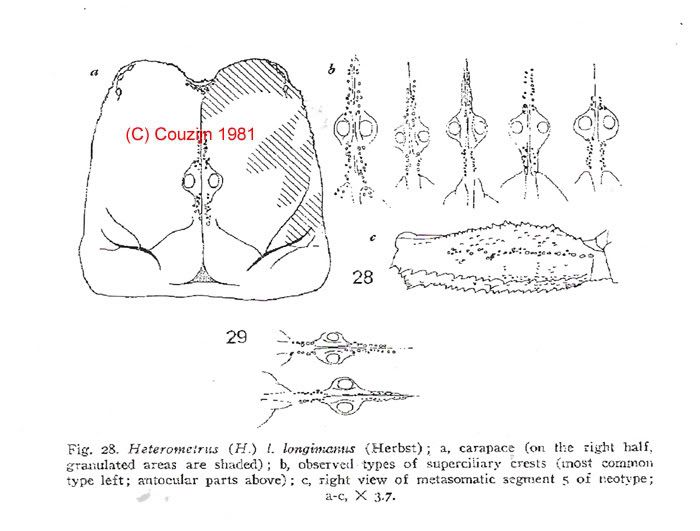- Joined
- May 2, 2006
- Messages
- 301
Identifying Common Heterometrus Revised
The original thread by George Carnell himself:
http://www.arachnoboards.com/ab/showthread.php?t=82335
Covering the species: H. petersii, H. laoticus, H. spinifer, H. longimanus,
H. cyaneus and H. fulvipes.
NOTE: Kovaøík's Revision of the Genus Heterometrus in 2004 made all subspecies void.
While some people still use them, I will not cover them.
I felt George's orignial thread didn't go indepth. It worked, but some lower level members of the hobby were still lost. Hopefully this will straighten a few things up.
Heterometrus Ehrenberg, 1828
petersii (Thorell, 1876)
DIAGNOSIS - Adults 90-125 mm long. Base color of
adults uniformly black, only manus and telson may be
black. Pectinal teeth number 15-19 in both
sexes. Sexual dimorphism in proportions of pedipalps not
Noticeable, Males have a more pronounced tooth on movable
fingers of pedipalp. Chela are rounded, length to width
ratio 2 and 2.4 in both sexes. Much of the manus is smooth, with
smooth carinae mainly on the margins. Patella of pedipalp
without pronounced internal tubercle. Carapace with disc,
smooth and margins granulated. Telson hirsute, elongated, and
vesicle longer than aculeus.
NOTE: Diagnosis was actually slightly wrong, so I edited it a little bit.
Will be different compared the original revision by a word or two.
How to Identify - Like most Heterometrus, this species is completely black.
Which helps it be identified. The only scorpions with black telsons are H.
petersii, H. laoticus and sometimes H. spinifer. Now, to quickly make sure
it is not laoticus check the prosoma, carapace, head or which ever you'd
like to call it. If there is no granulation, it is not H. petersii. Now to
differ from spinifer is a bit harder, but not impossible. H. spinifer has
far less granulation than H. petersii. H. petersii also has more rounded chela, while H. spinifer has slightly elongated chela. See the granulation pattern below,
and the granulation pattern of H. spinifer to double check.

Heterometrus Ehrenberg, 1828
laoticus (Couzijn, 1981)
DIAGNOSIS - Adults 90-125 mm long. Base color of
adults uniformly black, only manus and telson may be
black . Pectinal teeth number 15-19 in both
sexes. Sexual dimorphism in proportions of pedipalps not
noticeable. Chela lobiform, its length to width ratio 2 and 2.3
in both sexes. Manus smooth, with or without smooth
carinae, sparsely and finely punctate. Patella of pedipalp
without pronounced internal tubercle. Carapace and
mesosoma, smooth without granules. Telson hirsute,
elongate, vesicle longer than aculeus.
NOTE: Diagnosis was actually slightly wrong, so I edited it a little bit.
Will be different compared the original revision by a word or two.
How to Identify - This is the ONLY Heterometrus species not to have
granulation on the carapace. In all honesty, this is the easiest species to
identify.

Heterometrus Ehrenberg, 1828
spinifer (Ehrenberg, 1828)
DIAGNOSIS - Adults 100-135 mm long. Base color of
adults uniformly black, only manus and telson may be
reddish brown or black. In juveniles base color reddish brown,
telson may be yellow. Pectinal teeth number 15-19 in
both sexes. Sexual dimorphism in proportions of
pedipalps not noticeable. Chela slightly lobiform, its
adult length to width ratio 2.4 and 2.6 in both sexes. Much of
manus smooth, with smooth carinae forming irregular
reticulation. Patella of pedipalp with pronounced internal
tubercle. Carapace with disc smooth and margins
granulate. Telson hirsute, elongate, vesicle longer than
aculeus.
NOTE: Diagnosis was actually slightly wrong, so I edited it a little bit.
Will be different compared the original revision by a word or two.
How to Identify - In my opinion, H. spinifer and H. longimanus are the
hardest species to differ. They both can have red telsons, and I've yet to
examine a H. spinifer with black telson. While some people say that you can
differ them by H. longimanus having longer pedipalps in general, my male H.
spinifer has elongated pedipalps as well. To start differing these two
species, you must look at the granulation pattern. H. longimanus have less
granulation which is in several "lines" on the carapace. H. spinifer will
have more granulation that has a "dip" or "curve" in the granulation
pattern. Look at both the H. spinifer and H. longimanus granulation patterns
to be sure.

Heterometrus Ehrenberg, 1828
longimanus (Herbst 1800)
DIAGNOSIS - Adults 90-140 mm long. Base color of
adults uniformly black, only manus and telson may be
reddish brown. Pectinal teeth number 12-18 in both
sexes. Male with chela, femur and patella of pedipalp
narrower and longer than in female. Male fingers of
pedipalp very long. Fixed fingers longer or at least as
long as manus of pedpalp. Chela not lobiform in male,
slightly lobiform in female, its length to width ratio 3.3 and
4.4 in male, ca. 2.4. in female. Much of manus smooth,
sparsely tuberculate. Patella of pedipalp with pronounced
internal tubercle. Carapace usually with disc smooth and
margins granulate, but sometimes entire surface
granulate. Telson hirsute, elongate, vesicle as long as or
longer than aculeus.
How to Identify - H. longimanus males have extremely long pedipalps, hence
the name. Females will also have slightly elongated pedipalps. This species
is very close to H. spinifer in the granulation patterns, but H. longimanus
has a small amount of granulation, and is more in "lines" of granulation. H.
spinifer will have more granulation, and the granulation has a "dip" or
"curve" in the granulation. See the granulation pattern of longimanus and
spinifer.

Heterometrus Ehrenberg, 1828
cyaneus (C. L. Koch, 1836)
DIAGNOSIS - Adults 95-117 mm long. Base color of
adults uniformly black to greenish black, only telson may
be reddish brown. Pectinal teeth number 12-16 in both
sexes. Sexual dimorphism in proportions of pedipalps not
noticeable. Chela lobiform, its length to width ratio in
adults between 2.0 and 2.3 in both sexes. Dorsal surface
of manus tuberculate. Carinae weakly indicated. Patella
of pedipalp without pronounced internal tubercle.
Carapace with disc smooth, at sides may be granulate.
Telson hirsute, bulbous, vesicle longer than aculeus.
How to Identify - H. cyaneus is heavily granulated all over the body, which
makes it pretty cool looking. Under bright light H. cyaneus will shine blue,
hence the name. H. cyaneus has a more "unique" granulation pattern, which
makes it easier to identify. If there is granulation practically touching
the median eyes, it is most likely H. cyaneus. See granulation pattern
below.

Heterometrus Ehrenberg, 1828
fulvipes (C. L. Koch, 1837)
DIAGNOSIS - Adults 70-100 mm long. Color of adults
uniformly reddish brown to black, legs and telson yellow
to yellowish or reddish brown, always lighter colored
than body. Pectinal teeth number 12-18 in both sexes.
Male has longer femur and patella of pedipalp. Chela
lobiform, its ratio between 1.7 and 1.9 in both sexes.
Male and female chela of different shape but
approximately same width. Entire manus covered by
large, rounded granules but devoid of carinae. Patella of
pedipalp without pronouced internal tubercle. Carapace
of juveniles and some females with disc smooth, at
margins granulate and anteriorly tuberculate. Males and
some females with entire carapace sparsely granulate.
Telson hirsute, vesicle longer than or as long as aculeus.
How to Identify - H. fulvipes is another "unique" Heterometrus in the pet
trade. Unlike the general amount of Heterometrus sp, this species has more
color to them. This color makes them much more attractive to the majority to
people. This species is often imported as H. xanthopus, but if you look at
Kovaøík revision, the difference between the two species is very visible.

Souces-
Kovarik 2004
Couzjn 1981
Mike
The original thread by George Carnell himself:
http://www.arachnoboards.com/ab/showthread.php?t=82335
Covering the species: H. petersii, H. laoticus, H. spinifer, H. longimanus,
H. cyaneus and H. fulvipes.
NOTE: Kovaøík's Revision of the Genus Heterometrus in 2004 made all subspecies void.
While some people still use them, I will not cover them.
I felt George's orignial thread didn't go indepth. It worked, but some lower level members of the hobby were still lost. Hopefully this will straighten a few things up.
Heterometrus Ehrenberg, 1828
petersii (Thorell, 1876)
DIAGNOSIS - Adults 90-125 mm long. Base color of
adults uniformly black, only manus and telson may be
black. Pectinal teeth number 15-19 in both
sexes. Sexual dimorphism in proportions of pedipalps not
Noticeable, Males have a more pronounced tooth on movable
fingers of pedipalp. Chela are rounded, length to width
ratio 2 and 2.4 in both sexes. Much of the manus is smooth, with
smooth carinae mainly on the margins. Patella of pedipalp
without pronounced internal tubercle. Carapace with disc,
smooth and margins granulated. Telson hirsute, elongated, and
vesicle longer than aculeus.
NOTE: Diagnosis was actually slightly wrong, so I edited it a little bit.
Will be different compared the original revision by a word or two.
How to Identify - Like most Heterometrus, this species is completely black.
Which helps it be identified. The only scorpions with black telsons are H.
petersii, H. laoticus and sometimes H. spinifer. Now, to quickly make sure
it is not laoticus check the prosoma, carapace, head or which ever you'd
like to call it. If there is no granulation, it is not H. petersii. Now to
differ from spinifer is a bit harder, but not impossible. H. spinifer has
far less granulation than H. petersii. H. petersii also has more rounded chela, while H. spinifer has slightly elongated chela. See the granulation pattern below,
and the granulation pattern of H. spinifer to double check.

Heterometrus Ehrenberg, 1828
laoticus (Couzijn, 1981)
DIAGNOSIS - Adults 90-125 mm long. Base color of
adults uniformly black, only manus and telson may be
black . Pectinal teeth number 15-19 in both
sexes. Sexual dimorphism in proportions of pedipalps not
noticeable. Chela lobiform, its length to width ratio 2 and 2.3
in both sexes. Manus smooth, with or without smooth
carinae, sparsely and finely punctate. Patella of pedipalp
without pronounced internal tubercle. Carapace and
mesosoma, smooth without granules. Telson hirsute,
elongate, vesicle longer than aculeus.
NOTE: Diagnosis was actually slightly wrong, so I edited it a little bit.
Will be different compared the original revision by a word or two.
How to Identify - This is the ONLY Heterometrus species not to have
granulation on the carapace. In all honesty, this is the easiest species to
identify.

Heterometrus Ehrenberg, 1828
spinifer (Ehrenberg, 1828)
DIAGNOSIS - Adults 100-135 mm long. Base color of
adults uniformly black, only manus and telson may be
reddish brown or black. In juveniles base color reddish brown,
telson may be yellow. Pectinal teeth number 15-19 in
both sexes. Sexual dimorphism in proportions of
pedipalps not noticeable. Chela slightly lobiform, its
adult length to width ratio 2.4 and 2.6 in both sexes. Much of
manus smooth, with smooth carinae forming irregular
reticulation. Patella of pedipalp with pronounced internal
tubercle. Carapace with disc smooth and margins
granulate. Telson hirsute, elongate, vesicle longer than
aculeus.
NOTE: Diagnosis was actually slightly wrong, so I edited it a little bit.
Will be different compared the original revision by a word or two.
How to Identify - In my opinion, H. spinifer and H. longimanus are the
hardest species to differ. They both can have red telsons, and I've yet to
examine a H. spinifer with black telson. While some people say that you can
differ them by H. longimanus having longer pedipalps in general, my male H.
spinifer has elongated pedipalps as well. To start differing these two
species, you must look at the granulation pattern. H. longimanus have less
granulation which is in several "lines" on the carapace. H. spinifer will
have more granulation that has a "dip" or "curve" in the granulation
pattern. Look at both the H. spinifer and H. longimanus granulation patterns
to be sure.

Heterometrus Ehrenberg, 1828
longimanus (Herbst 1800)
DIAGNOSIS - Adults 90-140 mm long. Base color of
adults uniformly black, only manus and telson may be
reddish brown. Pectinal teeth number 12-18 in both
sexes. Male with chela, femur and patella of pedipalp
narrower and longer than in female. Male fingers of
pedipalp very long. Fixed fingers longer or at least as
long as manus of pedpalp. Chela not lobiform in male,
slightly lobiform in female, its length to width ratio 3.3 and
4.4 in male, ca. 2.4. in female. Much of manus smooth,
sparsely tuberculate. Patella of pedipalp with pronounced
internal tubercle. Carapace usually with disc smooth and
margins granulate, but sometimes entire surface
granulate. Telson hirsute, elongate, vesicle as long as or
longer than aculeus.
How to Identify - H. longimanus males have extremely long pedipalps, hence
the name. Females will also have slightly elongated pedipalps. This species
is very close to H. spinifer in the granulation patterns, but H. longimanus
has a small amount of granulation, and is more in "lines" of granulation. H.
spinifer will have more granulation, and the granulation has a "dip" or
"curve" in the granulation. See the granulation pattern of longimanus and
spinifer.

Heterometrus Ehrenberg, 1828
cyaneus (C. L. Koch, 1836)
DIAGNOSIS - Adults 95-117 mm long. Base color of
adults uniformly black to greenish black, only telson may
be reddish brown. Pectinal teeth number 12-16 in both
sexes. Sexual dimorphism in proportions of pedipalps not
noticeable. Chela lobiform, its length to width ratio in
adults between 2.0 and 2.3 in both sexes. Dorsal surface
of manus tuberculate. Carinae weakly indicated. Patella
of pedipalp without pronounced internal tubercle.
Carapace with disc smooth, at sides may be granulate.
Telson hirsute, bulbous, vesicle longer than aculeus.
How to Identify - H. cyaneus is heavily granulated all over the body, which
makes it pretty cool looking. Under bright light H. cyaneus will shine blue,
hence the name. H. cyaneus has a more "unique" granulation pattern, which
makes it easier to identify. If there is granulation practically touching
the median eyes, it is most likely H. cyaneus. See granulation pattern
below.

Heterometrus Ehrenberg, 1828
fulvipes (C. L. Koch, 1837)
DIAGNOSIS - Adults 70-100 mm long. Color of adults
uniformly reddish brown to black, legs and telson yellow
to yellowish or reddish brown, always lighter colored
than body. Pectinal teeth number 12-18 in both sexes.
Male has longer femur and patella of pedipalp. Chela
lobiform, its ratio between 1.7 and 1.9 in both sexes.
Male and female chela of different shape but
approximately same width. Entire manus covered by
large, rounded granules but devoid of carinae. Patella of
pedipalp without pronouced internal tubercle. Carapace
of juveniles and some females with disc smooth, at
margins granulate and anteriorly tuberculate. Males and
some females with entire carapace sparsely granulate.
Telson hirsute, vesicle longer than or as long as aculeus.
How to Identify - H. fulvipes is another "unique" Heterometrus in the pet
trade. Unlike the general amount of Heterometrus sp, this species has more
color to them. This color makes them much more attractive to the majority to
people. This species is often imported as H. xanthopus, but if you look at
Kovaøík revision, the difference between the two species is very visible.

Souces-
Kovarik 2004
Couzjn 1981
Mike





